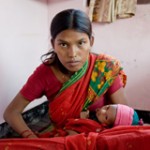
According to global statistics and hospital based data in Nepal, major causes of newborn deaths in Nepal are infection, birth asphyxia, preterm birth, and hypothermia. Three-quarters of all newborn deaths occur during the first week of life, 25–45% in the first 24 hours. This is also the period when most maternal deaths occur.
The underlying factors for this burden of death are the gap in continuum of care along life cycle (from mother to newborn to child) as well as from household to hospital, low institutional deliveries, lack of skilled care at pregnancy, delivery and post-natal period, inadequate access to and utilization of quality care, and poor maternal nutrition.
Over the past decade, the country, however, has had success in reduction of under-five mortality – largely owing to the implementation of community based child health programs at scale throughout the country over the past decade, particularly vitamin A supplementation and Community Based Integrated Management of Childhood Illnesses (CB-IMCI) services provided by Female Community Health Volunteers (FCHV). The learning’s and experiences gained in child health programming thus rationalized the need and probable success of a community-based newborn care program in Nepal.
As an affirmative action to cut down the newborn deaths significantly, MoHP in its policies and programs has incorporated newborn health as an integral component of safe motherhood efforts since late 1990s and further endorsed National Neonatal Health Strategy in 2004.. Guided by the National Strategy, Community Based Newborn Care Program has been developed in 2007 with the goal to improve the health and survival of newborn babies. The program has been envisioned and designed for integration into the safe motherhood and child health programs.
What we do
Program Goal: To improve the health and survival of newborn babies
Program Objectives:
- To prevent and manage newborn infections
- To prevent and manage hypothermia and low birth weight (LBW) babies
- To manage post delivery asphyxia
- To develop an effective system for referral of sick newborns
Program Strategies:
- District planning
- District level orientation to all relevant stakeholders
- Training for different levels
- Central and regional level training for trainers and participants: doctors, nurses, skilled birth attendants (SBA), senior staffs of district health and population and technical staff of partner organizations
- Health worker training at district and sub-district levels
- FCHV training at community level
- Newborn care service and referral at health facilities
- Communication for community awareness and better behavioral practices
- Monitoring, supervision and evaluation
Interventions Included in the Package
- Behavior Change Communication (BCC)
- Promotion of institutional delivery and clean delivery practices in case of home deliveries
- Postnatal care
- Community case management of pneumonia/ Possible Severe Bacterial Infection (PSBI)
- Care of LBW newborns
- Prevention and management of hypothermia
- Recognition of asphyxia, initial stimulation and resuscitation of newborn baby
Role of Female Community Health Volunteer (FCHV) in CB-NCP
The FCHV is identified as the pillar for implementation of CB-NCP. The FCHV, who are in continuous contact with the community people and from the same ward, will be provided with the performance based incentive at the completion of the set of identified activities. Major role undertaken by FCHV is to identify and counsel pregnant women, encourage institutional delivery, advice/accompany the mother to the health facility for delivery and provide home based newborn care on day 1, 3 and 7. Assess newborn and effective and timely referral of sick newborn to appropriate health facility.
Role of Health Workers and Health Facilities
For an effective and successful implementation of CB-NCP, an effective system of referral needs to be established at all level of health facilities. Cooperation of Health Facility Operation and Management Committee is also vital for the success of the program. Health managers, technical supervisors and community health workers will be responsible to provide supportive supervision to FCHV and newborn care providers.
Program Implementing Districts
CB-NCP is being pilot implemented in 10 districts of the country viz. Dhunkuta, Sunsari and Morang in the Eastern Region; Kavre, Parsa and Chitwan in the Central; Palpa in the Western; Dang and Bardiya in the Mid Western; and Doti in the Far Western. Based on lessons learnt and recommendations from these 10 pilot districts, CB-NCP will be adapted and gradually scaled up through out the country.
Major FIVE messages of newborn care
- Wipe the newborn with soft and dry cloth immediately after birth
- Put the newborn on mother’s chest and initiate skin-to-skin (STS) contact.
- Advice and support the mother on early and exclusive breastfeeding (within the first hour of birth) and exclusive breastfeeding till 6 months.
- Do not put anything on the cord stump, keep it clean and dry to protect from infection.
- Bathe newborn only after 24 hours of birth


